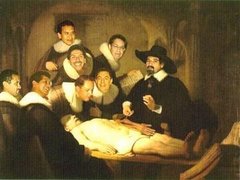Progeria es una enfermedad genética de la infancia extremadamente rara, caracterizada por un gran envejecimiento brusco y prematuro en niños entre su primer y segundo año de vida. Se estima que afecta a uno de cada 7 millones de recién nacidos vivos. No se ha evidenciado preferencia por ningún sexo en particular, pero se han comunicado muchos más pacientes de etnia blanca (97% de los pacientes afectados). La progeria puede afectar diferentes órganos y tejidos: hueso, músculos, piel, tejido subcutáneo y vasos. Desarrollan baja estatura, cráneo de gran tamaño, alopecia, piel seca y arrugada, ausencia de grasa subcutánea, rigidez articular. Al no existir cura ni tratamiento, las personas que lo padecen, no exceden los 13 o 15 años de vida.
La forma más severa de esta enfermedad es la llamada síndrome de Hutchinson-Gilford nombrada así en honor de Jonathan Hutchinson, quien fue el primero en descubrirla en 1886 y de Hutchinson-Gilford quien realizó diferentes estudios acerca de su desarrollo y características en 1904.
Al nacer, en los niños con progeria no se aprecian características especiales, aunque en algunos casos pueden percibirse: forma esculpida de la nariz, esclerodermas y cianosis facial. Los síntomas se manifiestan durante el primer año, con una o varias de las siguientes anomalías: retardo en el crecimiento, alopecia y anomalías en la piel, debido a la disminución de la producción de sudor por parte de las glándulas sudoríparas. Hacia el segundo año se añaden otros síntomas, como la caída del cabello. Las manifestaciones clínicas de la progeria se clasifican en criterios mayores y signos que usualmente están presentes. Los criterios mayores incluyen facies delgadas o finas, alopecia, venas prominentes en la calota, ojos grandes, micrognatia, dentición anormal y retardada, tórax "acampanado" en apariencia de pera, clavículas cortas, piernas arqueadas como jinete, extremidades superiores delgadas con articulaciones prominentes, talla baja, peso bajo para la talla, maduración sexual incompleta y disminución de la grasa subcutánea. Los signos que usualmente están presentes son piel esclerodérmica, alopecia generalizada, orejas prominentes con ausencia de lóbulos, nariz ganchuda, labios delgados con cianosis periodal, paladar alto, fontanela anterior permeable, voz de tono alto y uñas distróficas. En conclusión, el diagnóstico de la progeria es fundamentalmente clínico y se declara en niños que presentan los signos iniciales de la enfermedad mencionados al comienzo y que manifiesten todos los criterios mayors.
Sam Berns murió el viernes 10 de enero por la tarde debido a las complicaciones de esta rara enfermedad genética, según la Fundación para la Investigación de la Progeria.
Tenía diecisiete años.
En la foto con sus padres los doctores Dr. Scott Berns, y la Dra. Leslie Gordon ambos pediatras.
http://lifeaccordingtosam.com/#/home/
http://youtu.be/36m1o-tM05g
The Short, Exuberant Life of Sam Berns
By ROBIN MARANTZ HENIG
Judging from media appearances last year that brought him a kind of celebrity — first as the subject of an HBO documentary, then as a speaker at a TEDx conference — Sam Berns seemed to be far healthier than anyone could have anticipated back in 2005, when I wrote about him for the magazine. My article focused on his mother’s search for a cure for his disease, progeria, a rare genetic disorder that makes children seem to age before your eyes, with damage to organ systems — particularly the heart, skin and bones — usually seen only in the very old.
So it was a surprise, — even though children with progeria die, on average, at age 13, usually of heart attacks or strokes — when Sam died suddenly last Friday. He was 17.
Like so many others who came into Sam’s orbit, I was swept up by the force of his spirited personality as soon as I met him. He was 7, and he bossed me around the playroom at his home in Foxboro, Mass., racing me through a tour of his Legos constructions, a game of air hockey, a session at his half-size drums. As a teenager, he seemed calmer but no less exuberant. “I put myself in front of you to let you know that you don’t need to feel bad for me,” he said in the documentary “Life According to Sam.” Progeria was just part of his life, he said; more interesting to him was going to school and chilling with friends and getting backstage passes to see the Dave Matthews Band.
Sam’s parents, Leslie Gordon and Scott Berns, devoted their lives to finding a cure. Together with Leslie’s sister, Audrey Gordon, they founded the Progeria Research Foundation to finance basic research into the disease. Leslie, a pediatrician in training who shifted gears to do genetics research as soon as Sam’s progeria was diagnosed, was part of the team that found the progeria gene; their discovery, and the unusual involvement of a patient’s mother, was the impetus for my article in 2005. Eventually the scientists were able to describe the gene’s action, which in turn led to clinical trials of a promising drug, lonafarnib, that began in 2007.
Sam’s parents, Leslie Gordon and Scott Berns, devoted their lives to finding a cure. Together with Leslie’s sister, Audrey Gordon, they founded the Progeria Research Foundation to finance basic research into the disease. Leslie, a pediatrician in training who shifted gears to do genetics research as soon as Sam’s progeria was diagnosed, was part of the team that found the progeria gene; their discovery, and the unusual involvement of a patient’s mother, was the impetus for my article in 2005. Eventually the scientists were able to describe the gene’s action, which in turn led to clinical trials of a promising drug, lonafarnib, that began in 2007.
In the years since I first met Sam, I stayed curious about how he was doing, feeling little bursts of pride — and, frankly, relief — whenever I heard him on the radio or read about some new accomplishment (his latest was being named to the National Honor Society at Foxboro High School, where he was a junior).
Preliminary results of the lonafarnib study, published in 2012, showed that in most of the 28 children in the study — including Sam — the drug led to weight gain, improved bone structure and reversal of the blood vessel changes that put them at risk of heart attack or stroke. But a real cure is still elusive, and didn’t come soon enough for Sam.
Sam’s premature physical aging seemed to bring with it some precocious wisdom. At his TEDx talk last October, he mentioned being hospitalized for a chest infection a few months earlier. During that time, he said, “sometimes I had to be brave. It wasn’t always easy. Sometimes I faltered; I had bad days. But I realized that being brave isn’t supposed to be easy.”














No hay comentarios.:
Publicar un comentario